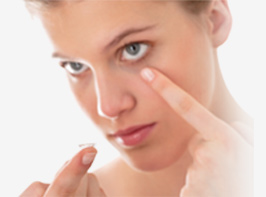








 |
CONTACT LENS INTERACTIONS WITH THE OCULAR
SURFACE AND ADNEXA
It would appear obvious that the interactions of a contact lens with the ocular surface and tear film are critical in the successful wear of the lens and the development of CLD. This subcommittee investigated the impact of contact lenses on the ocular surface and attempted to link these interactions to the development of CLD. A thorough review of the literature identified many dozens of ocular surface tissue alterations that may occur as a result of lens wear. While many of these result in frank pain (e.g., microbial keratitis), it was determined that such obvious pathologic complications were not the remit of this exercise and that the subcommittee would consider only potential tissue alterations that were associated with CLD (as defined above), and not pain that remained upon removal of the lens.
The cornea serves as the major surface on which the lens sits and could be a significant factor in CLD, particularly as it relates to its neurobiology. However, morphologic and apoptotic changes within the corneal epithelium have not been linked to CLD, nor have any changes in corneal epithelial barrier function. Despite many publications examining corneal staining associated with CL wear, overall, there appears to be, at best, a weak link between CLD and corneal staining, and it is not a major factor for most CL wearers. No stromal (keratocyte density, stromal opacities, stromal infiltrates, and stromal neovascularization), endothelial, or limbal (redness or stem cell deficiency) changes induced by lens wear were proven to be associated with CLD. While hypoxia can be a complication with many lens types or designs, no specific association with any hypoxic changes or marker of hypoxia could be linked directly to CLD.
The conjunctiva proved to be a tissue more closely linked to the development of CLD. Bulbar conjunctival staining, typically viewed using lissamine green, was found in some studies to be associated with CLD, particularly soft lens edge-related staining, and this may be related to lens edge design. While edge design and modulus may be linked to the development of conjunctival epithelial flaps, there appears to be no association between this tissue change and CLD. Bulbar hyperemia was not linked to CLD. Cytologic changes in the bulbar conjunctiva do occur in some wearers with CLD, but the many months it takes to reverse these changes obviously argues against a strong association with CLD, as CLD is relieved rapidly by removal of the lens from the eye.
The palpebral conjunctiva has an important role in controlling the interaction with the ocular surface and lens. Two specific issues potentially linked to CLD include alterations to the meibomian glands and to the leading edge of the palpebral conjunctiva as it moves across the lens surface (the so-called ‘‘lid-wiper’’ zone). Contact lens wear does appear to impact the function of the meibomian glands and reduced meibomian gland function has been associated with contact lens wear, but further studies are required for confirmation. Alterations to the lid-wiper area are more common in contact lens wearers who are symptomatic, and some studies have related these tissue changes to CLD. However, further work is necessary to investigate whether lid wiper epitheliopathy (LWE) is caused by specific properties of the lens material,whether upper LWE is more or less relevant than lower LWE, whether making changes to contact lens properties, rewetting drops, or solutions can influence positively the degree of LWE, and to what extent modification of LWE will alleviate CLD. Finally, the lid margin is colonized more frequently with microbes than the conjunctiva, but the frequency of isolation varies between wearers. The role of lid microbiota has been studied only superficially during CLD and this also is an area worthy of future study, given that microbial toxins can impact ocular comfort.
In conclusion, some evidence is available to suggest a link between conjunctival and lid changes with CLD, with the strongest evidence being that related to meibomian gland and LWE changes. No convincing evidence of a link to CLD was unearthed with respect to any of the other forms of CL- associated tissue changes. Future studies would benefit from longitudinal designs that attempt to understand what patho- physiologic changes occur in new wearers over time, and whether changes to lens materials, design, fit, or other factors impact these tissue changes. Studies also should examine whether the magnitude or timing of such changes can be related to the magnitude and timing of CLD.
|














